Society and Tourism: Investigating Sociological Principles, Theories, and Practices
VerifiedAdded on 2023/06/06
|10
|2910
|285
AI Summary
This essay explores the relationship between society and tourism, investigating sociological principles, theories, and practices. It discusses the positive and negative impacts of tourism on society, the Leiper's tourism system model, tourism life cycle, push and pull influences, and more.
Contribute Materials
Your contribution can guide someone’s learning journey. Share your
documents today.
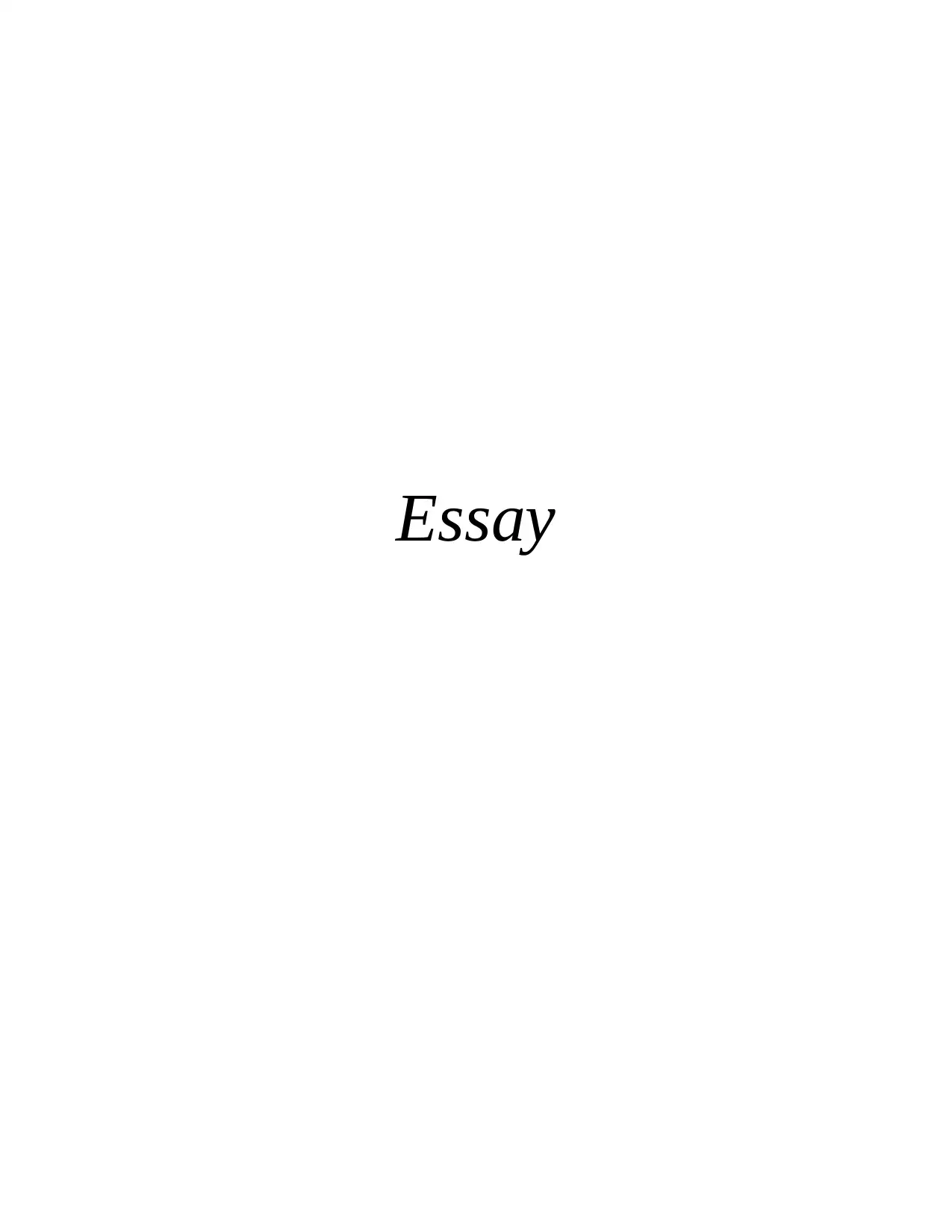
Essay
Secure Best Marks with AI Grader
Need help grading? Try our AI Grader for instant feedback on your assignments.
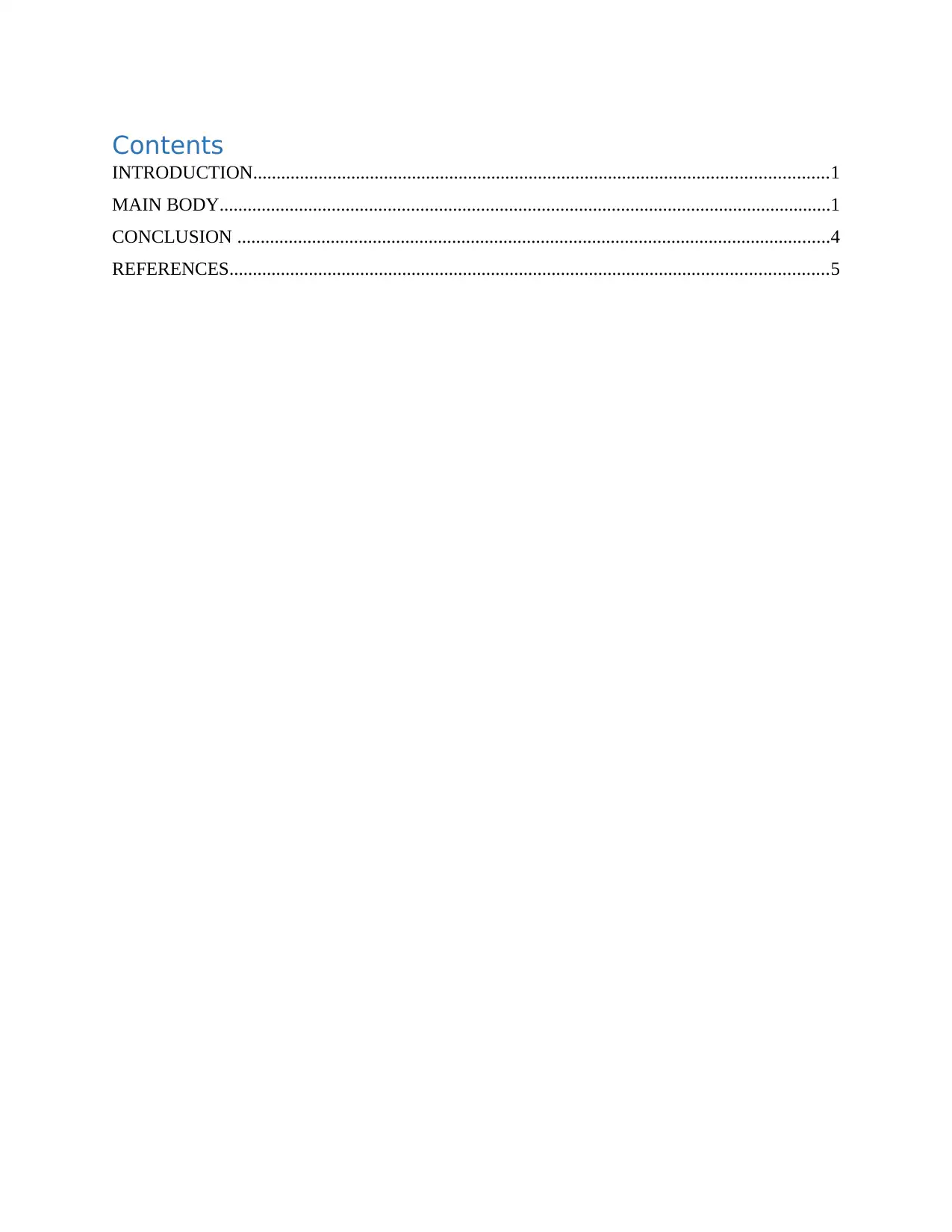
Contents
INTRODUCTION...........................................................................................................................1
MAIN BODY...................................................................................................................................1
CONCLUSION ...............................................................................................................................4
REFERENCES................................................................................................................................5
INTRODUCTION...........................................................................................................................1
MAIN BODY...................................................................................................................................1
CONCLUSION ...............................................................................................................................4
REFERENCES................................................................................................................................5
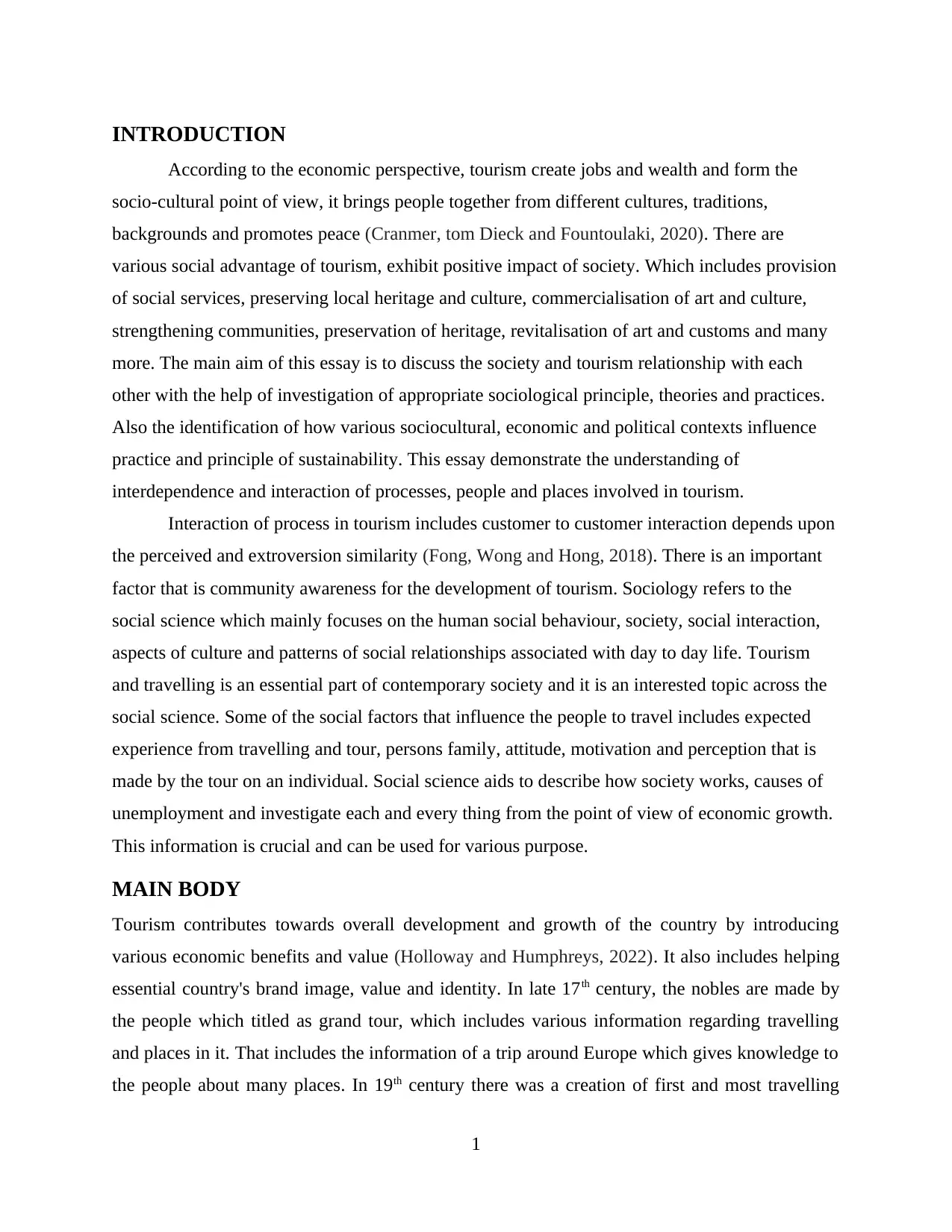
INTRODUCTION
According to the economic perspective, tourism create jobs and wealth and form the
socio-cultural point of view, it brings people together from different cultures, traditions,
backgrounds and promotes peace (Cranmer, tom Dieck and Fountoulaki, 2020). There are
various social advantage of tourism, exhibit positive impact of society. Which includes provision
of social services, preserving local heritage and culture, commercialisation of art and culture,
strengthening communities, preservation of heritage, revitalisation of art and customs and many
more. The main aim of this essay is to discuss the society and tourism relationship with each
other with the help of investigation of appropriate sociological principle, theories and practices.
Also the identification of how various sociocultural, economic and political contexts influence
practice and principle of sustainability. This essay demonstrate the understanding of
interdependence and interaction of processes, people and places involved in tourism.
Interaction of process in tourism includes customer to customer interaction depends upon
the perceived and extroversion similarity (Fong, Wong and Hong, 2018). There is an important
factor that is community awareness for the development of tourism. Sociology refers to the
social science which mainly focuses on the human social behaviour, society, social interaction,
aspects of culture and patterns of social relationships associated with day to day life. Tourism
and travelling is an essential part of contemporary society and it is an interested topic across the
social science. Some of the social factors that influence the people to travel includes expected
experience from travelling and tour, persons family, attitude, motivation and perception that is
made by the tour on an individual. Social science aids to describe how society works, causes of
unemployment and investigate each and every thing from the point of view of economic growth.
This information is crucial and can be used for various purpose.
MAIN BODY
Tourism contributes towards overall development and growth of the country by introducing
various economic benefits and value (Holloway and Humphreys, 2022). It also includes helping
essential country's brand image, value and identity. In late 17th century, the nobles are made by
the people which titled as grand tour, which includes various information regarding travelling
and places in it. That includes the information of a trip around Europe which gives knowledge to
the people about many places. In 19th century there was a creation of first and most travelling
1
According to the economic perspective, tourism create jobs and wealth and form the
socio-cultural point of view, it brings people together from different cultures, traditions,
backgrounds and promotes peace (Cranmer, tom Dieck and Fountoulaki, 2020). There are
various social advantage of tourism, exhibit positive impact of society. Which includes provision
of social services, preserving local heritage and culture, commercialisation of art and culture,
strengthening communities, preservation of heritage, revitalisation of art and customs and many
more. The main aim of this essay is to discuss the society and tourism relationship with each
other with the help of investigation of appropriate sociological principle, theories and practices.
Also the identification of how various sociocultural, economic and political contexts influence
practice and principle of sustainability. This essay demonstrate the understanding of
interdependence and interaction of processes, people and places involved in tourism.
Interaction of process in tourism includes customer to customer interaction depends upon
the perceived and extroversion similarity (Fong, Wong and Hong, 2018). There is an important
factor that is community awareness for the development of tourism. Sociology refers to the
social science which mainly focuses on the human social behaviour, society, social interaction,
aspects of culture and patterns of social relationships associated with day to day life. Tourism
and travelling is an essential part of contemporary society and it is an interested topic across the
social science. Some of the social factors that influence the people to travel includes expected
experience from travelling and tour, persons family, attitude, motivation and perception that is
made by the tour on an individual. Social science aids to describe how society works, causes of
unemployment and investigate each and every thing from the point of view of economic growth.
This information is crucial and can be used for various purpose.
MAIN BODY
Tourism contributes towards overall development and growth of the country by introducing
various economic benefits and value (Holloway and Humphreys, 2022). It also includes helping
essential country's brand image, value and identity. In late 17th century, the nobles are made by
the people which titled as grand tour, which includes various information regarding travelling
and places in it. That includes the information of a trip around Europe which gives knowledge to
the people about many places. In 19th century there was a creation of first and most travelling
1
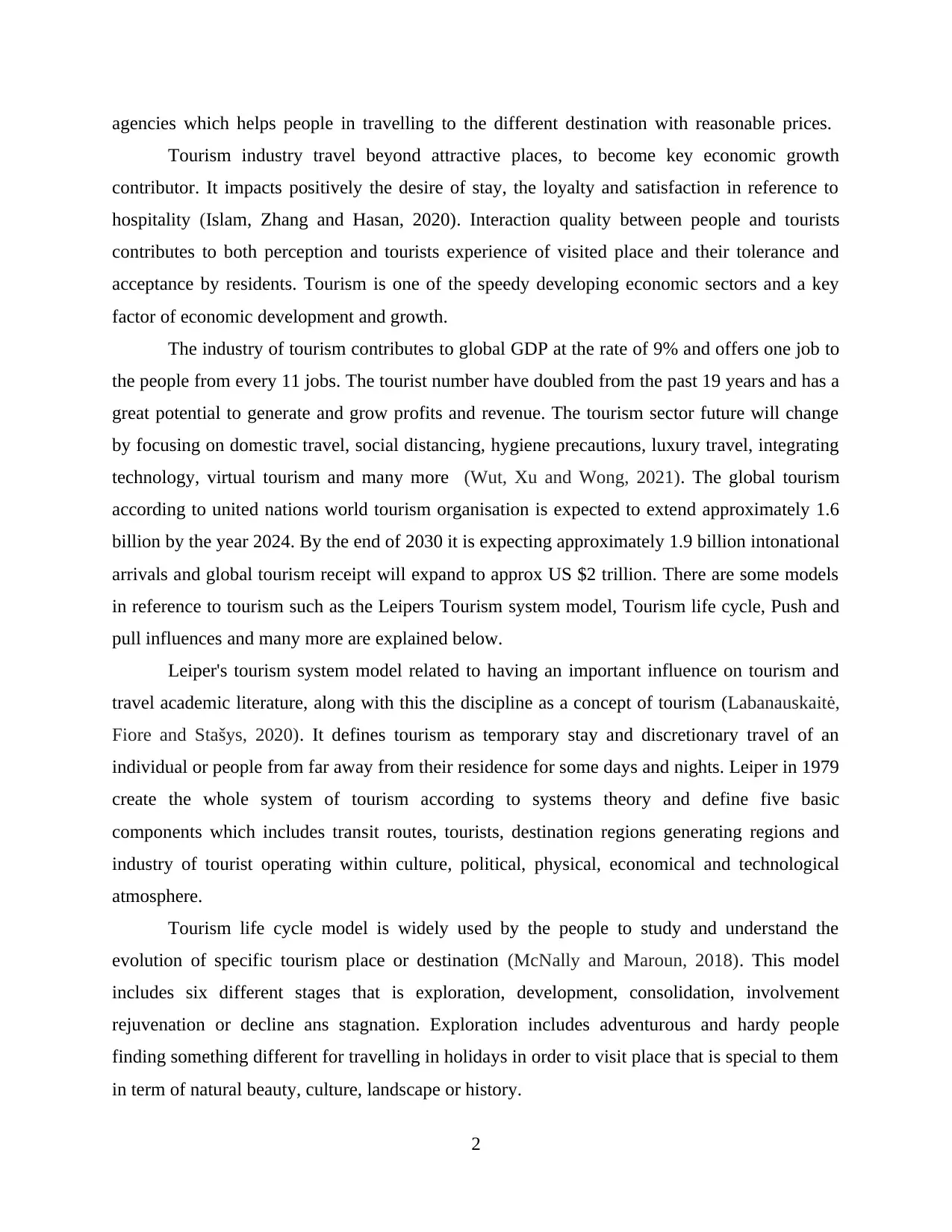
agencies which helps people in travelling to the different destination with reasonable prices.
Tourism industry travel beyond attractive places, to become key economic growth
contributor. It impacts positively the desire of stay, the loyalty and satisfaction in reference to
hospitality (Islam, Zhang and Hasan, 2020). Interaction quality between people and tourists
contributes to both perception and tourists experience of visited place and their tolerance and
acceptance by residents. Tourism is one of the speedy developing economic sectors and a key
factor of economic development and growth.
The industry of tourism contributes to global GDP at the rate of 9% and offers one job to
the people from every 11 jobs. The tourist number have doubled from the past 19 years and has a
great potential to generate and grow profits and revenue. The tourism sector future will change
by focusing on domestic travel, social distancing, hygiene precautions, luxury travel, integrating
technology, virtual tourism and many more (Wut, Xu and Wong, 2021). The global tourism
according to united nations world tourism organisation is expected to extend approximately 1.6
billion by the year 2024. By the end of 2030 it is expecting approximately 1.9 billion intonational
arrivals and global tourism receipt will expand to approx US $2 trillion. There are some models
in reference to tourism such as the Leipers Tourism system model, Tourism life cycle, Push and
pull influences and many more are explained below.
Leiper's tourism system model related to having an important influence on tourism and
travel academic literature, along with this the discipline as a concept of tourism (Labanauskaitė,
Fiore and Stašys, 2020). It defines tourism as temporary stay and discretionary travel of an
individual or people from far away from their residence for some days and nights. Leiper in 1979
create the whole system of tourism according to systems theory and define five basic
components which includes transit routes, tourists, destination regions generating regions and
industry of tourist operating within culture, political, physical, economical and technological
atmosphere.
Tourism life cycle model is widely used by the people to study and understand the
evolution of specific tourism place or destination (McNally and Maroun, 2018). This model
includes six different stages that is exploration, development, consolidation, involvement
rejuvenation or decline ans stagnation. Exploration includes adventurous and hardy people
finding something different for travelling in holidays in order to visit place that is special to them
in term of natural beauty, culture, landscape or history.
2
Tourism industry travel beyond attractive places, to become key economic growth
contributor. It impacts positively the desire of stay, the loyalty and satisfaction in reference to
hospitality (Islam, Zhang and Hasan, 2020). Interaction quality between people and tourists
contributes to both perception and tourists experience of visited place and their tolerance and
acceptance by residents. Tourism is one of the speedy developing economic sectors and a key
factor of economic development and growth.
The industry of tourism contributes to global GDP at the rate of 9% and offers one job to
the people from every 11 jobs. The tourist number have doubled from the past 19 years and has a
great potential to generate and grow profits and revenue. The tourism sector future will change
by focusing on domestic travel, social distancing, hygiene precautions, luxury travel, integrating
technology, virtual tourism and many more (Wut, Xu and Wong, 2021). The global tourism
according to united nations world tourism organisation is expected to extend approximately 1.6
billion by the year 2024. By the end of 2030 it is expecting approximately 1.9 billion intonational
arrivals and global tourism receipt will expand to approx US $2 trillion. There are some models
in reference to tourism such as the Leipers Tourism system model, Tourism life cycle, Push and
pull influences and many more are explained below.
Leiper's tourism system model related to having an important influence on tourism and
travel academic literature, along with this the discipline as a concept of tourism (Labanauskaitė,
Fiore and Stašys, 2020). It defines tourism as temporary stay and discretionary travel of an
individual or people from far away from their residence for some days and nights. Leiper in 1979
create the whole system of tourism according to systems theory and define five basic
components which includes transit routes, tourists, destination regions generating regions and
industry of tourist operating within culture, political, physical, economical and technological
atmosphere.
Tourism life cycle model is widely used by the people to study and understand the
evolution of specific tourism place or destination (McNally and Maroun, 2018). This model
includes six different stages that is exploration, development, consolidation, involvement
rejuvenation or decline ans stagnation. Exploration includes adventurous and hardy people
finding something different for travelling in holidays in order to visit place that is special to them
in term of natural beauty, culture, landscape or history.
2
Secure Best Marks with AI Grader
Need help grading? Try our AI Grader for instant feedback on your assignments.
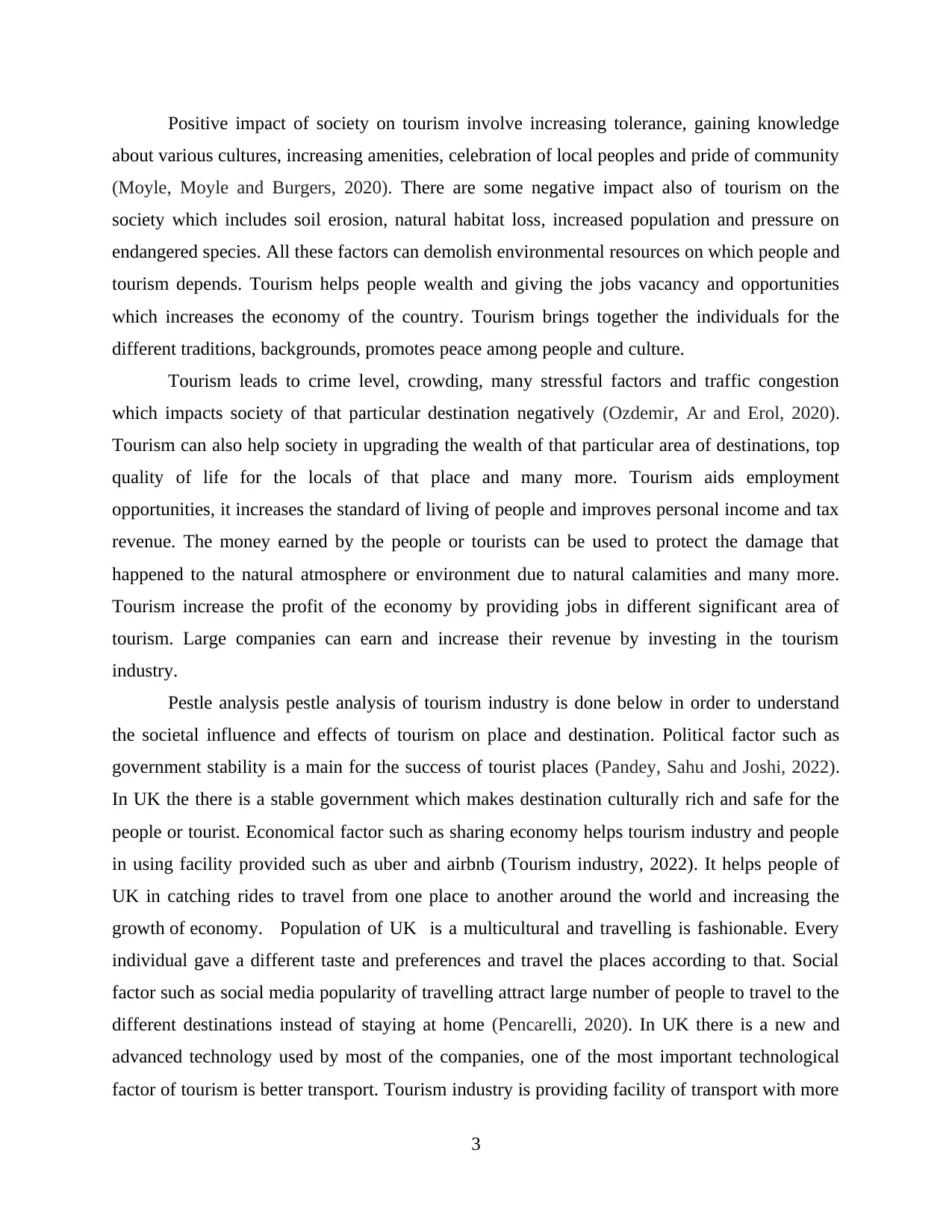
Positive impact of society on tourism involve increasing tolerance, gaining knowledge
about various cultures, increasing amenities, celebration of local peoples and pride of community
(Moyle, Moyle and Burgers, 2020). There are some negative impact also of tourism on the
society which includes soil erosion, natural habitat loss, increased population and pressure on
endangered species. All these factors can demolish environmental resources on which people and
tourism depends. Tourism helps people wealth and giving the jobs vacancy and opportunities
which increases the economy of the country. Tourism brings together the individuals for the
different traditions, backgrounds, promotes peace among people and culture.
Tourism leads to crime level, crowding, many stressful factors and traffic congestion
which impacts society of that particular destination negatively (Ozdemir, Ar and Erol, 2020).
Tourism can also help society in upgrading the wealth of that particular area of destinations, top
quality of life for the locals of that place and many more. Tourism aids employment
opportunities, it increases the standard of living of people and improves personal income and tax
revenue. The money earned by the people or tourists can be used to protect the damage that
happened to the natural atmosphere or environment due to natural calamities and many more.
Tourism increase the profit of the economy by providing jobs in different significant area of
tourism. Large companies can earn and increase their revenue by investing in the tourism
industry.
Pestle analysis pestle analysis of tourism industry is done below in order to understand
the societal influence and effects of tourism on place and destination. Political factor such as
government stability is a main for the success of tourist places (Pandey, Sahu and Joshi, 2022).
In UK the there is a stable government which makes destination culturally rich and safe for the
people or tourist. Economical factor such as sharing economy helps tourism industry and people
in using facility provided such as uber and airbnb (Tourism industry, 2022). It helps people of
UK in catching rides to travel from one place to another around the world and increasing the
growth of economy. Population of UK is a multicultural and travelling is fashionable. Every
individual gave a different taste and preferences and travel the places according to that. Social
factor such as social media popularity of travelling attract large number of people to travel to the
different destinations instead of staying at home (Pencarelli, 2020). In UK there is a new and
advanced technology used by most of the companies, one of the most important technological
factor of tourism is better transport. Tourism industry is providing facility of transport with more
3
about various cultures, increasing amenities, celebration of local peoples and pride of community
(Moyle, Moyle and Burgers, 2020). There are some negative impact also of tourism on the
society which includes soil erosion, natural habitat loss, increased population and pressure on
endangered species. All these factors can demolish environmental resources on which people and
tourism depends. Tourism helps people wealth and giving the jobs vacancy and opportunities
which increases the economy of the country. Tourism brings together the individuals for the
different traditions, backgrounds, promotes peace among people and culture.
Tourism leads to crime level, crowding, many stressful factors and traffic congestion
which impacts society of that particular destination negatively (Ozdemir, Ar and Erol, 2020).
Tourism can also help society in upgrading the wealth of that particular area of destinations, top
quality of life for the locals of that place and many more. Tourism aids employment
opportunities, it increases the standard of living of people and improves personal income and tax
revenue. The money earned by the people or tourists can be used to protect the damage that
happened to the natural atmosphere or environment due to natural calamities and many more.
Tourism increase the profit of the economy by providing jobs in different significant area of
tourism. Large companies can earn and increase their revenue by investing in the tourism
industry.
Pestle analysis pestle analysis of tourism industry is done below in order to understand
the societal influence and effects of tourism on place and destination. Political factor such as
government stability is a main for the success of tourist places (Pandey, Sahu and Joshi, 2022).
In UK the there is a stable government which makes destination culturally rich and safe for the
people or tourist. Economical factor such as sharing economy helps tourism industry and people
in using facility provided such as uber and airbnb (Tourism industry, 2022). It helps people of
UK in catching rides to travel from one place to another around the world and increasing the
growth of economy. Population of UK is a multicultural and travelling is fashionable. Every
individual gave a different taste and preferences and travel the places according to that. Social
factor such as social media popularity of travelling attract large number of people to travel to the
different destinations instead of staying at home (Pencarelli, 2020). In UK there is a new and
advanced technology used by most of the companies, one of the most important technological
factor of tourism is better transport. Tourism industry is providing facility of transport with more
3
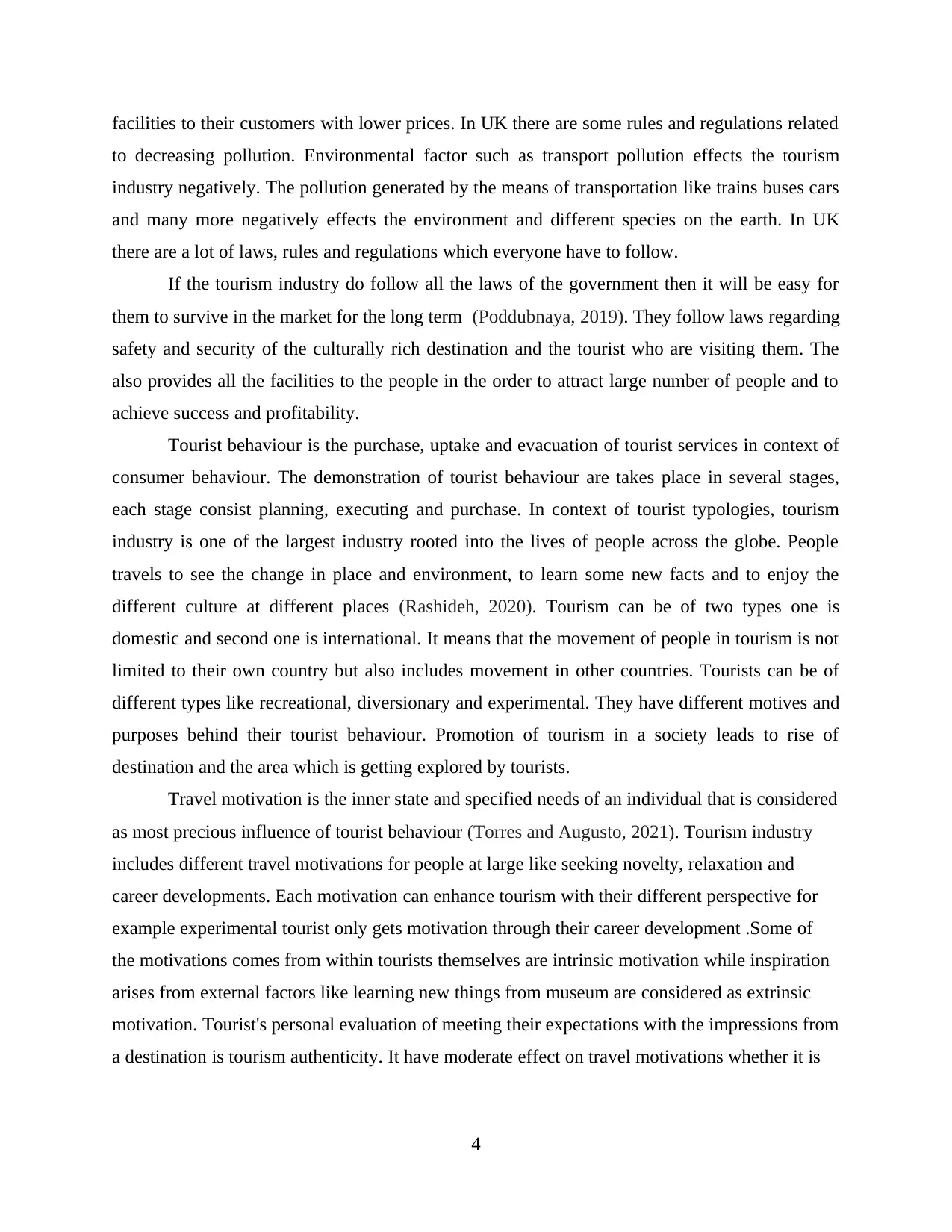
facilities to their customers with lower prices. In UK there are some rules and regulations related
to decreasing pollution. Environmental factor such as transport pollution effects the tourism
industry negatively. The pollution generated by the means of transportation like trains buses cars
and many more negatively effects the environment and different species on the earth. In UK
there are a lot of laws, rules and regulations which everyone have to follow.
If the tourism industry do follow all the laws of the government then it will be easy for
them to survive in the market for the long term (Poddubnaya, 2019). They follow laws regarding
safety and security of the culturally rich destination and the tourist who are visiting them. The
also provides all the facilities to the people in the order to attract large number of people and to
achieve success and profitability.
Tourist behaviour is the purchase, uptake and evacuation of tourist services in context of
consumer behaviour. The demonstration of tourist behaviour are takes place in several stages,
each stage consist planning, executing and purchase. In context of tourist typologies, tourism
industry is one of the largest industry rooted into the lives of people across the globe. People
travels to see the change in place and environment, to learn some new facts and to enjoy the
different culture at different places (Rashideh, 2020). Tourism can be of two types one is
domestic and second one is international. It means that the movement of people in tourism is not
limited to their own country but also includes movement in other countries. Tourists can be of
different types like recreational, diversionary and experimental. They have different motives and
purposes behind their tourist behaviour. Promotion of tourism in a society leads to rise of
destination and the area which is getting explored by tourists.
Travel motivation is the inner state and specified needs of an individual that is considered
as most precious influence of tourist behaviour (Torres and Augusto, 2021). Tourism industry
includes different travel motivations for people at large like seeking novelty, relaxation and
career developments. Each motivation can enhance tourism with their different perspective for
example experimental tourist only gets motivation through their career development .Some of
the motivations comes from within tourists themselves are intrinsic motivation while inspiration
arises from external factors like learning new things from museum are considered as extrinsic
motivation. Tourist's personal evaluation of meeting their expectations with the impressions from
a destination is tourism authenticity. It have moderate effect on travel motivations whether it is
4
to decreasing pollution. Environmental factor such as transport pollution effects the tourism
industry negatively. The pollution generated by the means of transportation like trains buses cars
and many more negatively effects the environment and different species on the earth. In UK
there are a lot of laws, rules and regulations which everyone have to follow.
If the tourism industry do follow all the laws of the government then it will be easy for
them to survive in the market for the long term (Poddubnaya, 2019). They follow laws regarding
safety and security of the culturally rich destination and the tourist who are visiting them. The
also provides all the facilities to the people in the order to attract large number of people and to
achieve success and profitability.
Tourist behaviour is the purchase, uptake and evacuation of tourist services in context of
consumer behaviour. The demonstration of tourist behaviour are takes place in several stages,
each stage consist planning, executing and purchase. In context of tourist typologies, tourism
industry is one of the largest industry rooted into the lives of people across the globe. People
travels to see the change in place and environment, to learn some new facts and to enjoy the
different culture at different places (Rashideh, 2020). Tourism can be of two types one is
domestic and second one is international. It means that the movement of people in tourism is not
limited to their own country but also includes movement in other countries. Tourists can be of
different types like recreational, diversionary and experimental. They have different motives and
purposes behind their tourist behaviour. Promotion of tourism in a society leads to rise of
destination and the area which is getting explored by tourists.
Travel motivation is the inner state and specified needs of an individual that is considered
as most precious influence of tourist behaviour (Torres and Augusto, 2021). Tourism industry
includes different travel motivations for people at large like seeking novelty, relaxation and
career developments. Each motivation can enhance tourism with their different perspective for
example experimental tourist only gets motivation through their career development .Some of
the motivations comes from within tourists themselves are intrinsic motivation while inspiration
arises from external factors like learning new things from museum are considered as extrinsic
motivation. Tourist's personal evaluation of meeting their expectations with the impressions from
a destination is tourism authenticity. It have moderate effect on travel motivations whether it is
4
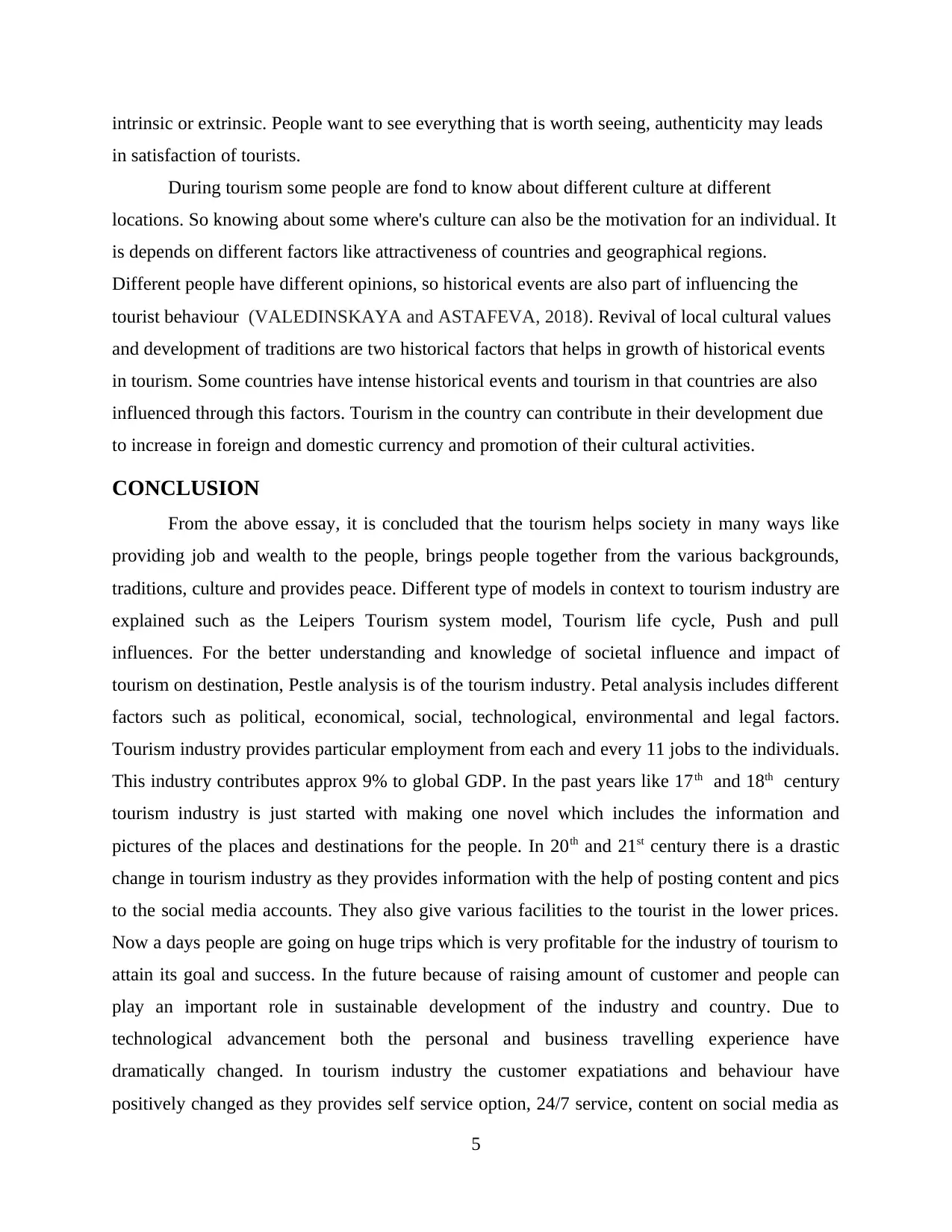
intrinsic or extrinsic. People want to see everything that is worth seeing, authenticity may leads
in satisfaction of tourists.
During tourism some people are fond to know about different culture at different
locations. So knowing about some where's culture can also be the motivation for an individual. It
is depends on different factors like attractiveness of countries and geographical regions.
Different people have different opinions, so historical events are also part of influencing the
tourist behaviour (VALEDINSKAYA and ASTAFEVA, 2018). Revival of local cultural values
and development of traditions are two historical factors that helps in growth of historical events
in tourism. Some countries have intense historical events and tourism in that countries are also
influenced through this factors. Tourism in the country can contribute in their development due
to increase in foreign and domestic currency and promotion of their cultural activities.
CONCLUSION
From the above essay, it is concluded that the tourism helps society in many ways like
providing job and wealth to the people, brings people together from the various backgrounds,
traditions, culture and provides peace. Different type of models in context to tourism industry are
explained such as the Leipers Tourism system model, Tourism life cycle, Push and pull
influences. For the better understanding and knowledge of societal influence and impact of
tourism on destination, Pestle analysis is of the tourism industry. Petal analysis includes different
factors such as political, economical, social, technological, environmental and legal factors.
Tourism industry provides particular employment from each and every 11 jobs to the individuals.
This industry contributes approx 9% to global GDP. In the past years like 17th and 18th century
tourism industry is just started with making one novel which includes the information and
pictures of the places and destinations for the people. In 20th and 21st century there is a drastic
change in tourism industry as they provides information with the help of posting content and pics
to the social media accounts. They also give various facilities to the tourist in the lower prices.
Now a days people are going on huge trips which is very profitable for the industry of tourism to
attain its goal and success. In the future because of raising amount of customer and people can
play an important role in sustainable development of the industry and country. Due to
technological advancement both the personal and business travelling experience have
dramatically changed. In tourism industry the customer expatiations and behaviour have
positively changed as they provides self service option, 24/7 service, content on social media as
5
in satisfaction of tourists.
During tourism some people are fond to know about different culture at different
locations. So knowing about some where's culture can also be the motivation for an individual. It
is depends on different factors like attractiveness of countries and geographical regions.
Different people have different opinions, so historical events are also part of influencing the
tourist behaviour (VALEDINSKAYA and ASTAFEVA, 2018). Revival of local cultural values
and development of traditions are two historical factors that helps in growth of historical events
in tourism. Some countries have intense historical events and tourism in that countries are also
influenced through this factors. Tourism in the country can contribute in their development due
to increase in foreign and domestic currency and promotion of their cultural activities.
CONCLUSION
From the above essay, it is concluded that the tourism helps society in many ways like
providing job and wealth to the people, brings people together from the various backgrounds,
traditions, culture and provides peace. Different type of models in context to tourism industry are
explained such as the Leipers Tourism system model, Tourism life cycle, Push and pull
influences. For the better understanding and knowledge of societal influence and impact of
tourism on destination, Pestle analysis is of the tourism industry. Petal analysis includes different
factors such as political, economical, social, technological, environmental and legal factors.
Tourism industry provides particular employment from each and every 11 jobs to the individuals.
This industry contributes approx 9% to global GDP. In the past years like 17th and 18th century
tourism industry is just started with making one novel which includes the information and
pictures of the places and destinations for the people. In 20th and 21st century there is a drastic
change in tourism industry as they provides information with the help of posting content and pics
to the social media accounts. They also give various facilities to the tourist in the lower prices.
Now a days people are going on huge trips which is very profitable for the industry of tourism to
attain its goal and success. In the future because of raising amount of customer and people can
play an important role in sustainable development of the industry and country. Due to
technological advancement both the personal and business travelling experience have
dramatically changed. In tourism industry the customer expatiations and behaviour have
positively changed as they provides self service option, 24/7 service, content on social media as
5
Paraphrase This Document
Need a fresh take? Get an instant paraphrase of this document with our AI Paraphraser
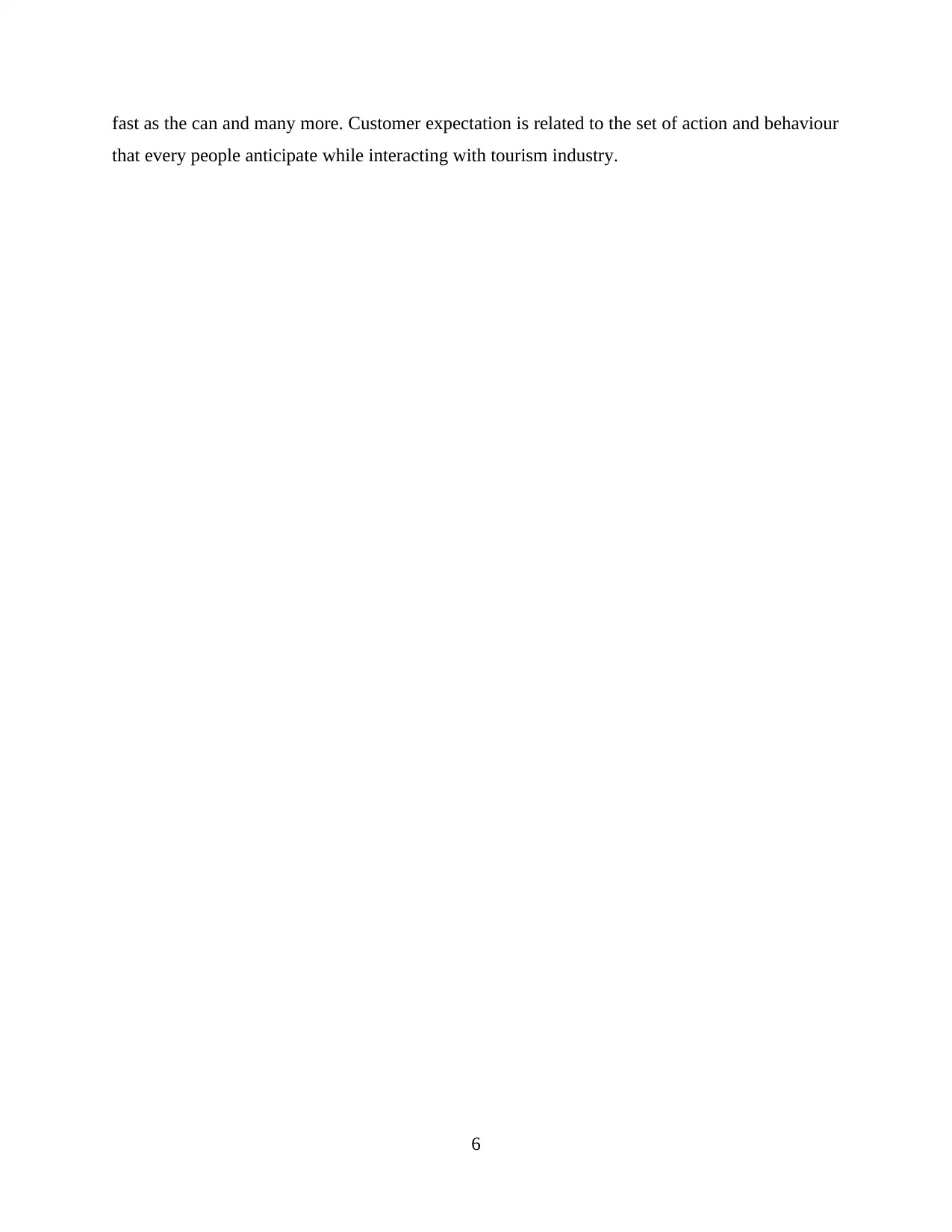
fast as the can and many more. Customer expectation is related to the set of action and behaviour
that every people anticipate while interacting with tourism industry.
6
that every people anticipate while interacting with tourism industry.
6
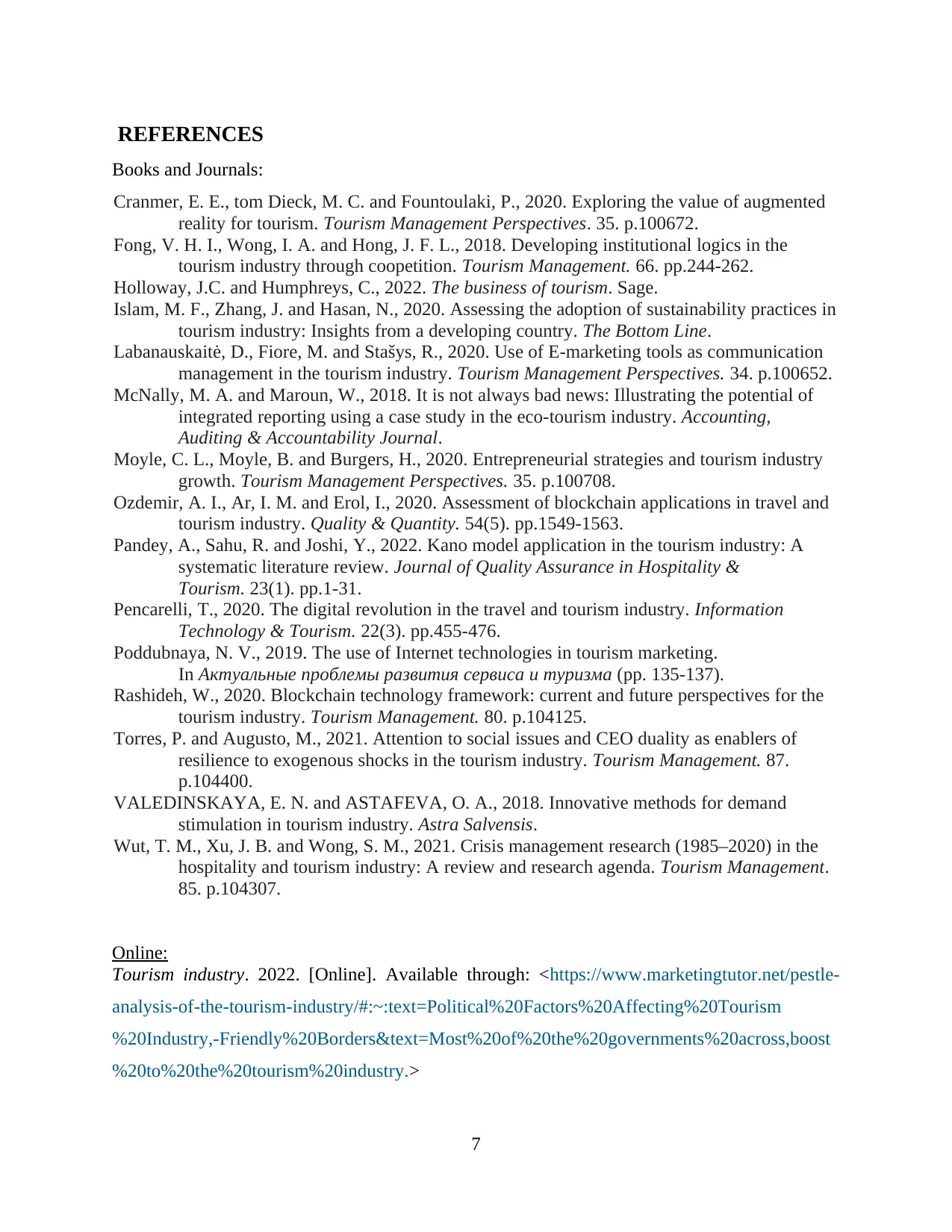
REFERENCES
Books and Journals:
Cranmer, E. E., tom Dieck, M. C. and Fountoulaki, P., 2020. Exploring the value of augmented
reality for tourism. Tourism Management Perspectives. 35. p.100672.
Fong, V. H. I., Wong, I. A. and Hong, J. F. L., 2018. Developing institutional logics in the
tourism industry through coopetition. Tourism Management. 66. pp.244-262.
Holloway, J.C. and Humphreys, C., 2022. The business of tourism. Sage.
Islam, M. F., Zhang, J. and Hasan, N., 2020. Assessing the adoption of sustainability practices in
tourism industry: Insights from a developing country. The Bottom Line.
Labanauskaitė, D., Fiore, M. and Stašys, R., 2020. Use of E-marketing tools as communication
management in the tourism industry. Tourism Management Perspectives. 34. p.100652.
McNally, M. A. and Maroun, W., 2018. It is not always bad news: Illustrating the potential of
integrated reporting using a case study in the eco-tourism industry. Accounting,
Auditing & Accountability Journal.
Moyle, C. L., Moyle, B. and Burgers, H., 2020. Entrepreneurial strategies and tourism industry
growth. Tourism Management Perspectives. 35. p.100708.
Ozdemir, A. I., Ar, I. M. and Erol, I., 2020. Assessment of blockchain applications in travel and
tourism industry. Quality & Quantity. 54(5). pp.1549-1563.
Pandey, A., Sahu, R. and Joshi, Y., 2022. Kano model application in the tourism industry: A
systematic literature review. Journal of Quality Assurance in Hospitality &
Tourism. 23(1). pp.1-31.
Pencarelli, T., 2020. The digital revolution in the travel and tourism industry. Information
Technology & Tourism. 22(3). pp.455-476.
Poddubnaya, N. V., 2019. The use of Internet technologies in tourism marketing.
In Актуальные проблемы развития сервиса и туризма (pp. 135-137).
Rashideh, W., 2020. Blockchain technology framework: current and future perspectives for the
tourism industry. Tourism Management. 80. p.104125.
Torres, P. and Augusto, M., 2021. Attention to social issues and CEO duality as enablers of
resilience to exogenous shocks in the tourism industry. Tourism Management. 87.
p.104400.
VALEDINSKAYA, E. N. and ASTAFEVA, O. A., 2018. Innovative methods for demand
stimulation in tourism industry. Astra Salvensis.
Wut, T. M., Xu, J. B. and Wong, S. M., 2021. Crisis management research (1985–2020) in the
hospitality and tourism industry: A review and research agenda. Tourism Management.
85. p.104307.
Online:
Tourism industry. 2022. [Online]. Available through: <https://www.marketingtutor.net/pestle-
analysis-of-the-tourism-industry/#:~:text=Political%20Factors%20Affecting%20Tourism
%20Industry,-Friendly%20Borders&text=Most%20of%20the%20governments%20across,boost
%20to%20the%20tourism%20industry.>
7
Books and Journals:
Cranmer, E. E., tom Dieck, M. C. and Fountoulaki, P., 2020. Exploring the value of augmented
reality for tourism. Tourism Management Perspectives. 35. p.100672.
Fong, V. H. I., Wong, I. A. and Hong, J. F. L., 2018. Developing institutional logics in the
tourism industry through coopetition. Tourism Management. 66. pp.244-262.
Holloway, J.C. and Humphreys, C., 2022. The business of tourism. Sage.
Islam, M. F., Zhang, J. and Hasan, N., 2020. Assessing the adoption of sustainability practices in
tourism industry: Insights from a developing country. The Bottom Line.
Labanauskaitė, D., Fiore, M. and Stašys, R., 2020. Use of E-marketing tools as communication
management in the tourism industry. Tourism Management Perspectives. 34. p.100652.
McNally, M. A. and Maroun, W., 2018. It is not always bad news: Illustrating the potential of
integrated reporting using a case study in the eco-tourism industry. Accounting,
Auditing & Accountability Journal.
Moyle, C. L., Moyle, B. and Burgers, H., 2020. Entrepreneurial strategies and tourism industry
growth. Tourism Management Perspectives. 35. p.100708.
Ozdemir, A. I., Ar, I. M. and Erol, I., 2020. Assessment of blockchain applications in travel and
tourism industry. Quality & Quantity. 54(5). pp.1549-1563.
Pandey, A., Sahu, R. and Joshi, Y., 2022. Kano model application in the tourism industry: A
systematic literature review. Journal of Quality Assurance in Hospitality &
Tourism. 23(1). pp.1-31.
Pencarelli, T., 2020. The digital revolution in the travel and tourism industry. Information
Technology & Tourism. 22(3). pp.455-476.
Poddubnaya, N. V., 2019. The use of Internet technologies in tourism marketing.
In Актуальные проблемы развития сервиса и туризма (pp. 135-137).
Rashideh, W., 2020. Blockchain technology framework: current and future perspectives for the
tourism industry. Tourism Management. 80. p.104125.
Torres, P. and Augusto, M., 2021. Attention to social issues and CEO duality as enablers of
resilience to exogenous shocks in the tourism industry. Tourism Management. 87.
p.104400.
VALEDINSKAYA, E. N. and ASTAFEVA, O. A., 2018. Innovative methods for demand
stimulation in tourism industry. Astra Salvensis.
Wut, T. M., Xu, J. B. and Wong, S. M., 2021. Crisis management research (1985–2020) in the
hospitality and tourism industry: A review and research agenda. Tourism Management.
85. p.104307.
Online:
Tourism industry. 2022. [Online]. Available through: <https://www.marketingtutor.net/pestle-
analysis-of-the-tourism-industry/#:~:text=Political%20Factors%20Affecting%20Tourism
%20Industry,-Friendly%20Borders&text=Most%20of%20the%20governments%20across,boost
%20to%20the%20tourism%20industry.>
7

8
1 out of 10
Related Documents
Your All-in-One AI-Powered Toolkit for Academic Success.
+13062052269
info@desklib.com
Available 24*7 on WhatsApp / Email
![[object Object]](/_next/static/media/star-bottom.7253800d.svg)
Unlock your academic potential
© 2024 | Zucol Services PVT LTD | All rights reserved.





